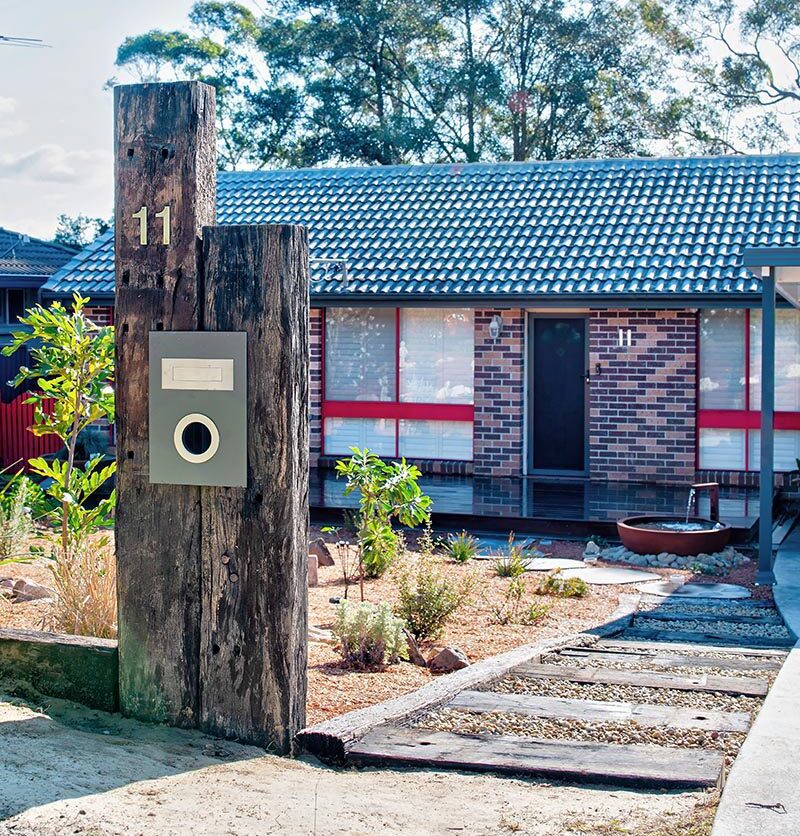
Our home, the NSW Blue Mountains offer a breathtaking landscape perfect for environmentally conscious landscaping practices. As urbanisation continues to spread, the need for sustainable landscaping design in this region becomes more crucial than ever.
This article explores the principles of green landscaping, with a focus on eco-friendly materials, native plants, reusing and repurposing materials and products. We will explore sustainable landscaping methods to attract wildlife, and additional ways to protect the environment in landscaped gardens.
Eco-Friendly Materials for Green Landscaping:
Choosing the right materials is a cornerstone of sustainable landscaping. Opting for locally sourced, recycled, or upcycled materials helps reduce the carbon footprint of landscaping projects. In the Blue Mountains, where sandstone is abundant, at Fresh Perspectives Landscapes, we love utilising this natural resource for pathways, retaining walls, and garden features. Using local sandstone not only enhances the aesthetics of your outdoor spaces, it also minimises transportation-related environmental impacts. Recycled plastic garden materials made from soft plastics are another excellent option for outdoor structures like fences and decking, offering durability without contributing to deforestation. Incorporating salvaged timber, recycled railway sleepers and reclaimed materials into garden furniture adds a rustic charm while promoting sustainability.


Native Plants of the NSW Blue Mountains:
Eco-friendly landscaping in the Blue Mountains involves embracing the natural beauty of the region. Utilising native plants is not only visually pleasing but also beneficial for local ecosystems. Plants like the iconic Waratah, Grevillea, and Kangaroo Paw are well-suited to the region’s climate, requiring less water and maintenance than non-native alternatives.
By incorporating these native species, gardens become vibrant, resilient, and better adapted to the local conditions. Using green landscaping plants fosters biodiversity, attracting native insects and pollinators essential for a thriving ecosystem.
Green Landscaping Ways to Reuse and Repurpose Materials:
Sustainable backyard landscaping goes beyond material selection; it involves creative ways to reuse and repurpose existing resources. Consider recycled landscaping materials, repurposing old bricks for garden borders or constructing raised beds using salvaged railway sleepers. Wine barrels can be transformed into water features or container gardens, adding both functionality and character to the landscape.
Broken tiles or pieces of discarded ceramics can be used for mosaic pathways, contributing to a unique and visually appealing garden design. By thinking outside the conventional landscaping box, you not only reduce waste but also infuse your garden with a distinctive personality.
Consider repurposing old garden tools as decorative elements or art pieces. Unused pallets can be transformed into vertical gardens or compost bins. Discarded metal items like old wheelbarrows or watering cans can be given new life as plant containers or sculptures, adding an industrial yet sustainable touch to the garden.
Reclaimed glass bottles can be used creatively as edging for flower beds or as unique garden borders. Broken ceramics can be turned into colorful mosaic stepping stones. The possibilities are endless when it comes to reusing materials creatively in sustainable garden design.


Ideas to attract Wildlife with Green Landscaping:
Green landscaping in the Blue Mountains aims to create harmonious spaces that invite wildlife. Instead of relying on conventional bird feeders, plant native flowering species like Banksia and Bottlebrush to attract local birds and insects. Incorporating water features, such as birdbaths or small ponds, provides a vital water source for wildlife.
Avoiding chemical pesticides and fertilizers promotes a healthier ecosystem. As an alternative, embrace natural solutions like compost and mulch to nourish the soil. By cultivating a balanced environment, your garden becomes a haven for butterflies, birds, and other native fauna.
Comparison with Tropical Gardens:
While both the Blue Mountains and tropical environments share a commitment to eco-friendly landscaping, the approaches differ due to distinct climatic conditions. In the Blue Mountains, where the climate is cooler, emphasis is placed on native flora adapted to colder temperatures. Water conservation is also a significant focus due to the region’s periodic droughts.
In contrast, tropical gardens prioritise plants that thrive in warm, humid climates. Native species such as palms, orchids, and ferns dominate, creating lush and vibrant landscapes. Water management is crucial in tropical gardens as well, but the focus is often on drainage and preventing waterlogging.
Ways to Protect the Environment:
- Rainwater Harvesting: Install rain barrels or underground tanks to collect rainwater, reducing reliance on mains water for irrigation.
- Solar-Powered Lighting: Illuminate your garden with solar-powered lights to minimize energy consumption and contribute to a more sustainable energy landscape.
- Composting Systems and Worm Farms: Establish composting bins and worm farms to recycle kitchen and garden waste, creating nutrient-rich compost and vermicompost for soil enrichment. Worms contribute to the breakdown of organic matter and enhance soil structure, providing a natural and sustainable fertilisation method.
- Natural Pest Control: Integrate companion planting and beneficial insect habitats to control pests naturally, minimising the need for chemical pesticides.
- Permeable Surfaces: Use permeable paving materials to reduce runoff and allow rainwater to penetrate the soil, preventing erosion and supporting groundwater recharge.
The amount of interest in adopting Green landscaping practices in the Blue Mountains is a testament to the region’s commitment to preserving its natural beauty and biodiversity. By incorporating eco-friendly materials, native plants, creative approaches to reusing and repurposing, additional environmental protection measures, and sustainable wildlife attraction, homeowners and landscapers alike can contribute to a sustainable future. Transforming outdoor spaces into havens for wildlife not only enhances the aesthetic appeal but also fosters a deeper connection with the environment.
As we embrace incorporating sustainable landscaping practices into our projects, Fresh Perspective Landscapes is hoping that the Blue Mountains can serve as a model for creating thriving, eco-conscious communities. If you are interested in eco landscaping ideas for your outdoor spaces, Contact Luke 0434 355 066 or on Facebook who can work with you on a sustainable garden design that is functional and beautiful.
Please provide us with information about your landscaping requirements so we can contact you to arrange a suitable consultation time.
Landscaping Enquiry
We invite everyone to support us through Facebook and Instagram, and to keep following our story!
Fresh Perspective Landscapes have extended our online presence via Facebook and Instagram promoting “a life outdoors”, a love of the Blue Mountains NSW, and spending quality time with family and friends in beautiful outdoor areas.


